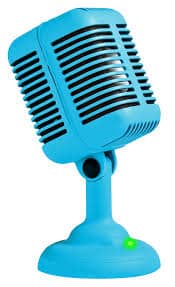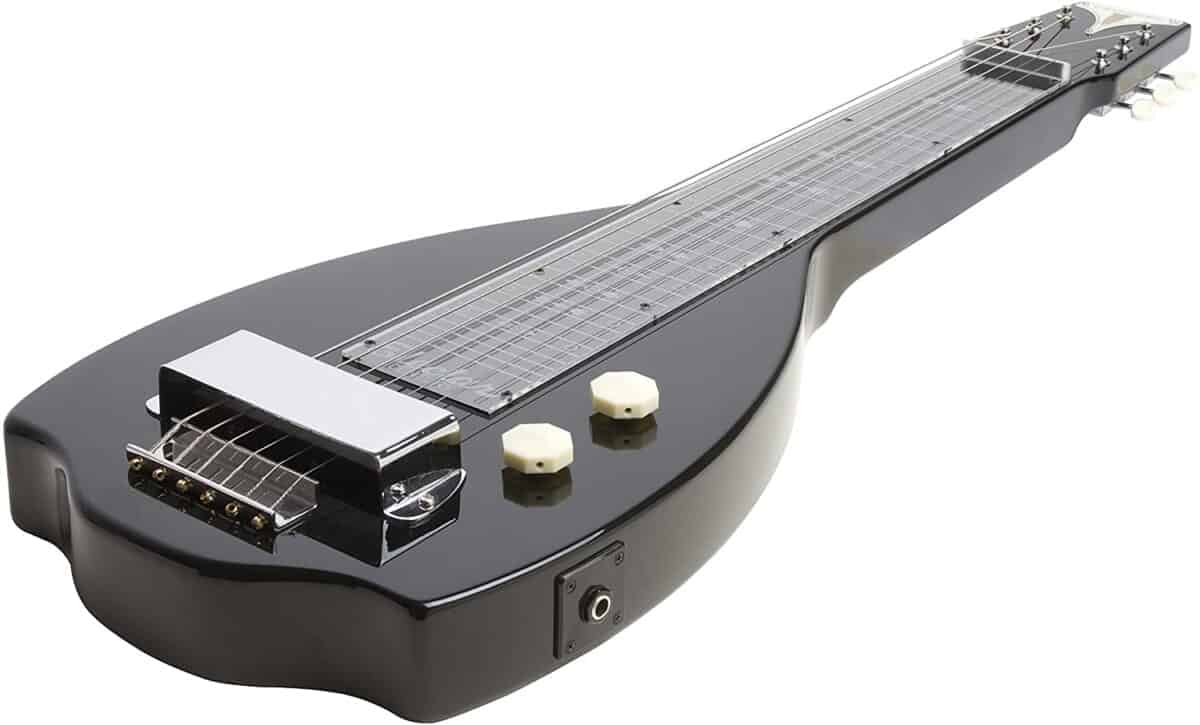One of the simplest constructed musical instruments in the world of music is the Lap Steel Guitar. It’s basically a two-by-four with 6 strings but can make some incredible sounds and when recorded can color the added tracks to a Country & Western, Blues, or most any genre when it’s miked and recorded the proper way. What’s the Best Mic Placement for Recording a Lap Steel Guitar.
There are 2 Mic Placements for Recording a Lap Steel Guitar:
1. 2 Mic Amp Technique-Use 2 Mics as close as possible but not touching
A Dynamic & Small Condenser mic-7-9 ” from an Amp- slightly off-axis
2. 2 Mic Analog Technique-use a Dynamic mic 3-4″ from the bridge & a Condenser 10″ off the guitar.
Lap Steel Guitars have a plugged-in electric sound, which also gives them a more sustained tone for playing single notes or chords that are picked or played with a slide. They are similar to a Pedal Steel Guitar and have roots in the Blues world and Country music and are considered a simple vintage Americana Instrument.
Dobro vs Lap steel
Both Instruments are played with Thumb and Finger picks along with a Slide that is made different. Both instruments are mainly tuned in E or C and open D that is popular in most types of music from Country to Rock. It is louder, more driven, and has a clearer smoother sound as opposed to Lap Steel.
Lap Steel is more forgiving and easier to play chords. The Lap Steel predated the Pedal Steel and was used first in Hawaiin music then Gospel which eventually found its way into Country music.
Pedal steel developed from regular steel guitar in the ’50s and is used often in music today. Pedal steel is a fairly large instrument that sits on legs. It has levers and pedals to change the tuning of various strings as the instrument is being played.
The number of pedals and levers varies from instrument to instrument. They are beautiful sounding instruments. Using a nice sustained, rounded sound they look great on stage. The Lap steel just sits on the lap of the player.
There are no pedals etc. The strings tend to be high above the neck. Of course, in both cases, the player uses a metal bar/slide on the strings to get the wanted notes. I love the sound of Tex-Mex Country Swing and the Country Western Sound. The Lap Steel produces the familiar ‘crying’ sound by diminishing the attack of the thumb and commonly two fingerpicks. Hawaiian music was popular in the late twenties that left a mark on American culture that’s still heard today.
Pedal steel requires the use of both hands, both feet, and knees. The string spacing is closer to pedal steel. Lap steel requires bar slants to overcome the limits of the tuning.
Proper intonation is difficult enough with a straight bar technique, but the bar slants required to overcome the limits of the non-pedal guitar step that degree of difficulty up a notch. In other words more commitment.
Back in the olden days before amplification, Instrument Maker Hermann Weissenborn conceived and built the first guitars specifically designed for lap playing. Made of koa wood and featuring square, hollow necks, the Weissenborns had a sweet tone, long sustain, and were louder than a regular acoustic guitar when played on one’s lap.
In 1925 Maui Style 4 Hawaiian steel guitar was made by Hermann Weissenborn of Los Angeles CA for Christophe’s of S.F. a distributor of Weissenborn-made instruments that were being sold as Maui Brand Hawaiian guitars.
Recording a Lap Steel Guitar
The 2 Microphone Amplifier Technique
When miking an amp, you’ll almost always get great results by combining a small-diameter condenser with a Shure SM57.
- Put the mics as close as possible to each other without touching. The farther apart they are, the greater the danger of phase cancellation.
- Microphone Placement for the Shure Sm57 and the Small Diameter Condenser about is 7-9 ” from the cone in the Amp-slightly off-axis
- Slant the Mic Capsules at a 15-degree angle
- The more center over the speaker the more highs will be picked up.
- You can cancel some of that high frequency by angling the capsule towards the edge of the Cone.
The 2 Microphone Analog Technique
While the SM 57/small-diameter condenser combo can prove to be the best miking setup in the analog universe. A large-diameter condenser model often provides the most professional sound. a large-diaphragm condenser with a cardioid pattern that will pick up a wider range of frequencies out a little farther away around 10 ” from the front, while Sm57 is able to be placed 3 or 4 inches from the soundhole.
Microphone placement is so important. You gotta know where the sweet spot is on your amp, especially if using a highly directional mic such as an SM57.
And if you are working in venues where they use a sound company, some of these guys don’t seem to know very much about proper mic placement as it relates to the tone of the steel so you need to be aware. Incidentally, you can get some great color tones that can come from some inexpensive mics when Placement is right.
- When using the Amplifier Technique use a stand that will be able to tilt and position the mic and pinpoint the sweet spot on the cone of the speaker.
- On the amp/mic track, listen to the mic as it’s recording through headphones and move the position slightly around till you like what you hear. You’ll notice that as the mic is positioned closer to the center of the cone the eq will shift.
- Many engineers and sound people prefer to place the mic slightly off-axis (not straight perpendicular) and point it somewhere between the edge of the speaker and the edge of the cone, usually pretty close (only a few inches).
- Don’t clip track
- Don’t add any reverb now or any effects that you may be stuck with
Best Mic for Recording a Steel Guitar
The Rode NT1000 Studio Cardioid Condenser Microphone is a warm beautiful sounding mic that uses it with a Shure SM-57 Cardioid Dynamic Instrument Microphone
right up on the amp and a Rode NT 1000 about 3 feet away from the amp and record together. Rode mics are relatively inexpensive and outperform everything in their class and well beyond.
When you are done recording you can mix the two channels to your liking. I think this is the best way to go. This mic has a solid metal build and a wide, warm-sounding range. The pick-up on this mic is incredible. I’ve personally used it for acoustic instruments, and vocals, and love it
Another Dynamic that can do the jog close up to the Amp is Sennheiser e906 Supercardioid Dynamic Mic for Guitar Amps
 The Sennheiser e906 is a high-quality dynamic microphone with a super-cardioid pick-up pattern, ideal for miking guitar amps, percussion instruments, snares, and toms. Its laterally mounted capsule has been specially developed for miking guitars amps face on and extremely close to the signal source which is what you want to get the sound from the Lap Steel.
The Sennheiser e906 is a high-quality dynamic microphone with a super-cardioid pick-up pattern, ideal for miking guitar amps, percussion instruments, snares, and toms. Its laterally mounted capsule has been specially developed for miking guitars amps face on and extremely close to the signal source which is what you want to get the sound from the Lap Steel.
Another Cardioiod Microphone Sennheiser MD 421 II Cardioid Dynamic Mic The large diaphragm, dynamic element handles high sound pressure levels, making it a natural for recording guitars and drums. The MD 421’s full-bodied cardioid pattern and five-position bass control make it an excellent choice for most instruments, as well as group vocals or radio broadcast announcers.
Pedal Steel Guitar Sound
The SM57 sounds more natural and picks up a bit less extraneous noise. You do have to make sure you have a real SM57 and not one of the cheap knock-offs. For inexpensive techniques, use the SM 57 & 58’s all day long
 Partnered up with a condenser forth close-up microphone placement. The Pedal Steel has that sound that is familiar with Country Western music from the ’50s that gives it a Classic feel and texture not familiar in other genres of music. There’s something special about what exactly a Lap Steel Instrument can bring to the table.
Partnered up with a condenser forth close-up microphone placement. The Pedal Steel has that sound that is familiar with Country Western music from the ’50s that gives it a Classic feel and texture not familiar in other genres of music. There’s something special about what exactly a Lap Steel Instrument can bring to the table.
Always use incremental changes when mic positions and placement are being experimented with. Everything matters including the room and Amplifiers being used. There are no set rules when using Mic Placeplacement.
Use a Start and listen, then work from there. The mics you use in this situation are the most important aspect because of the techniques used here and how they work together.
Still with a solid Dynamic like the Shure 57 and a reliable Condenser mic like the Sennheiser e906 Supercardioid Dynamic Mic for Guitar Amps you can get a lot of Bang for your Buck without giving up quality.
JimGalloway Editor/Author

MikingDesign.com


